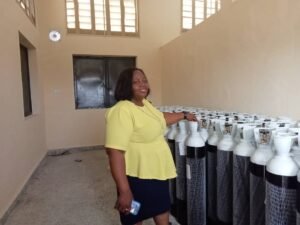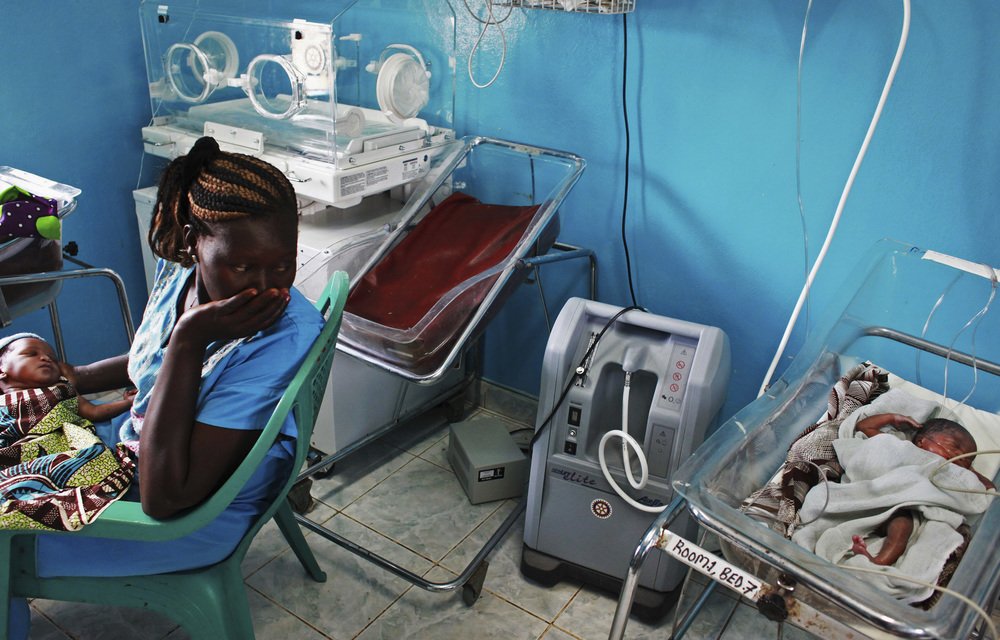In the vibrant city of Abuja, Nigeria, expecting mothers eagerly anticipate the arrival of their little ones. However, amid their excitement lies a profound concern – the shortage of vital medical equipment, such as oxygen machines, in primary healthcare facilities, posing a significant threat to the survival of their newborns, should an emergency arise. Gom Mirian visited some primary healthcare facilities and shares her findings on oxygen scarcity and infant survival rates through personal stories, healthcare workers’ perspectives, expert opinions and statistics.
Nigeria, with its rapidly growing population, grapples with high neonatal mortality rates. According to the World Health Organisation (WHO), approximately 37 out of every 1,000 Nigerian newborns do not survive their first month of life. Shockingly, around 75 per cent of neonatal deaths occur within the first week of life, and in 2019 alone, about 1 million newborns died within the first 24 hours. Oxygen scarcity in primary healthcare facilities exacerbates these alarming statistics. These facilities, often lacking essential medical equipment, struggle to provide adequate care for newborns in need of oxygen support.

The leading causes of neonatal deaths in Nigeria include preterm birth, intrapartum-related complications (birth asphyxia or the inability to breathe at birth), infections, and birth defects, according to the WHO’s 2021 report on newborn mortality.
Personal Stories and Testimonials
Rashidat Friday, a young expectant mother who recently visited the Aleyita Primary Healthcare Facility along Airport Road in Abuja, shares her concerns. “As my due date approaches, I can’t help but worry about the lack of oxygen machines in these facilities. What if my baby faces complications during delivery? Will there be enough oxygen to save their life?”

“Even though I would prefer delivering my baby in a primary healthcare (PHC) facility due to the love, attention, and care given to us here, the fear of sudden birth complications remains,” she said. “I plead with the Federal Capital Territory Authority (FCTA) to provide at least one oxygen machine here so that our children can survive.”
Rashidat’s fears are echoed by another expectant mother, Joy Muhammad, who tragically recalls her neighbor’s loss of a baby in a primary health care centre due to prolonged labour.
“I didn’t know such cases could be averted or that a child could have survived if only an oxygen machine was available to resuscitate the baby,” she lamented. “What if complications arise during childbirth, how will my baby receive the life-saving oxygen they may desperately need? These concerns weigh heavily on my mind.”

Insights from Experts and Health Workers
The Principal Nurse Officer at Mubushi Primary Health Care Centre, Lucy Gausinu Yunana, highlights the critical issue of oxygen machine scarcity in primary healthcare facilities. She informs AHR that many newborns suffer from birth asphyxia or respiratory distress syndrome, necessitating immediate oxygen support.
“Unfortunately, we lack this essential equipment. We do not even have a bag valve mask (Ambu Bag),” she lamented. “We are limited in our ability to provide adequate care, leading to preventable deaths.
“We are grateful that we have not had to deal with cases of birth asphyxia or other emergencies, but when they (emergencies) do arise, we are forced to refer the children to a general hospital for proper treatment. In most cases, our referrals do not get the needed attention at the tertiary facilities due to a lack of bed space, and some end up losing their lives.
“Despite voicing our concerns to the FCT authority and various NGOs, no action has been taken to address our lack of resources,” she added.

A registered midwife at Aleyita Primary Healthcare Centre, Nurse Okolorie Perpetual, adds to the conversation. “We often receive expectant mothers, newborns, and even adults in critical condition, struggling to breathe. However, due to the absence of oxygen machines, we are compelled to transfer them to the National Hospital or Federal Medical Centre, fully aware that we lack the necessary tools to save them. The absence of oxygen machines leaves us feeling helpless and frustrated.”
Another health worker at Area 2 Primary Healthcare Centre, requesting anonymity, confirms the absence of an oxygen machine at the facility and stresses that “oxygen machines are vital in treating various medical emergencies, including pneumonia, sepsis, and asthma. The lack of this equipment significantly hampers our efforts to reduce neonatal mortality rates in primary healthcare facilities.”

Expert Perspectives
A consultant pediatrician, Dr. Simon-Peter, emphasises the urgent need for oxygen machines in primary healthcare facilities. “Oxygen is a lifeline for newborns facing respiratory distress or birth asphyxia. Without immediate access to oxygen, their chances of survival diminish significantly. Investing in oxygen machines is crucial to reducing neonatal mortality rates in Nigeria.”
Dr Jonathan Dangana, a public health expert, adds, “Oxygen scarcity not only affects newborns during delivery but also hampers the management of respiratory illnesses in infants. Pneumonia, a leading cause of death among children under five, requires oxygen therapy for effective treatment. The absence of oxygen machines in primary healthcare facilities limits our ability to save lives.”
Such lives that could have been saved is Joy’s neighbor’s baby whose story was highlighted earlier. Her newborn baby struggled to breathe shortly after birth, but the facility lacked an oxygen machine, leading to a rapid deterioration of the child’s condition. By the time the child was transferred to a tertiary hospital, it was too late. “If only there had been oxygen available, my neighbor’s long-awaited child might have been saved,” Joy bitterly recounts.
Importance of Oxygen Machines in Primary Healthcare
Oxygen machines play a crucial role in saving lives during childbirth and managing respiratory illnesses in newborns. They provide immediate access to oxygen, ensuring that infants receive the necessary support to breathe and recover. The presence of oxygen machines in primary healthcare facilities offers several benefits: timely intervention, enhanced care, and reduced referrals.
Timely Intervention: Oxygen machines enable healthcare providers to respond promptly to birth complications, reducing the risk of long-term health issues or death.
Enhanced Care: With oxygen machines, healthcare professionals can provide comprehensive, life-saving interventions, improving outcomes for distressed newborns.
Reduced Referrals: Having oxygen machines in primary healthcare facilities reduces the need for emergency transfers to tertiary hospitals, minimizing delays in receiving critical care.
Economic Implications
The economic impact of oxygen scarcity cannot be ignored. Emergency transfers to tertiary hospitals, extended hospital stays, and long-term care for children with disabilities resulting from oxygen deprivation place a heavy burden on families. Additionally, the strain on the healthcare system leads to increased healthcare expenditure. Investing in oxygen machines in primary healthcare facilities not only saves lives but also reduces the financial burden on families and the healthcare system.
International Perspectives
International organisations, such as UNICEF, recognise the importance of oxygen availability in primary healthcare facilities. To bridge the gap in healthcare services, UNICEF built an oxygen plant equipped with 200 oxygen cylinders at the Ogale Nchia General Hospital in the Eleme local government area of Rivers State. This plant was donated to the state government to ensure that all communities, regardless of their location, have access to life-saving interventions like oxygen.
During a site visit to Port Harcourt, AHR discovered that the oxygen plant donated by UNICEF, capable of serving five local government areas within Eleme, is the first of its kind to be owned by the state in its 56 years of existence, despite its oil-rich revenue.
Dr. Iroro Smith, a reproductive health coordinator at Rivers State Ministry of Health, explained, “Oxygen is a lifesaving commodity, especially for newborns, children, and adults suffering from respiratory illnesses or complications. The establishment of this oxygen plant is a significant milestone for healthcare in Rivers State. Previously, Rivers State relied solely on a privately-owned oxygen plant to meet the needs of its clients.”

She expressed concerns about the shortage of medical personnel alongside the importance of the newly donated oxygen plant. “Its impact will be felt in five local government areas, including Okrika, Eleme, Tai, Gokam and Khana,” she said.
“Before the establishment of this oxygen plant, we always struggled to provide adequate oxygen for our patients. Quarterly, 600 to 1000 cases of birth asphyxia were recorded in the state out of which 50 per cent of the cases did not survive.”
Successful initiatives from countries like Rwanda and Malawi demonstrate the positive impact of investing in oxygen machines. Nigeria must learn from these examples and prioritise the provision of oxygen machines to ensure the survival of its youngest citizens.
Oxygen scarcity in Nigerian primary healthcare facilities poses a significant threat to child survival. The alarming statistics of avoidable illuminates the urgent need for action. Policymakers, healthcare authorities, and stakeholders need to prioritise the provision of oxygen machines in primary healthcare facilities. By doing so, countless lives would be saved and a brighter future set for Nigeria’s children.



